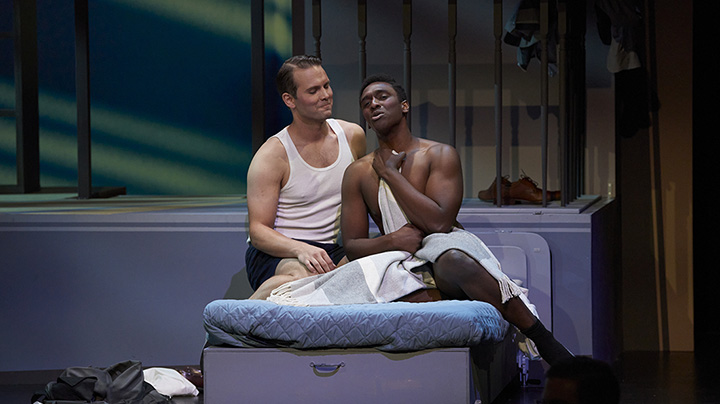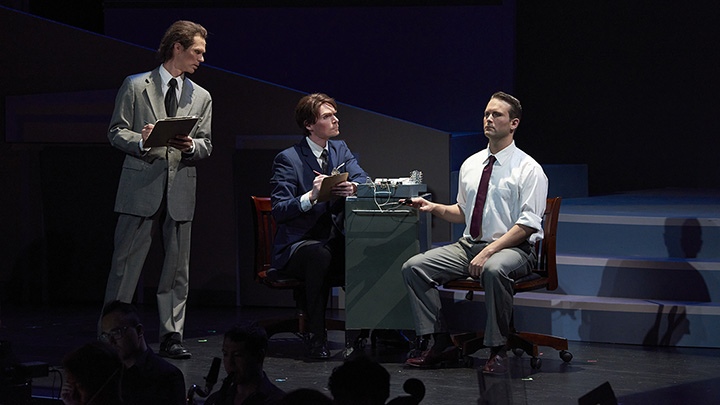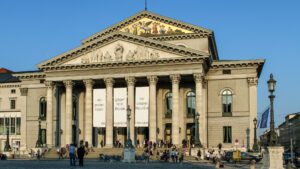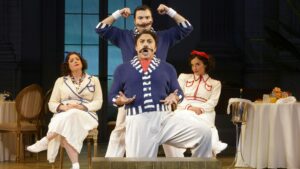This opera, co-commissioned by Cincinnati Opera and G. Sterling Zinsmeyer, premiered at Cincinnati Opera in June 2016 and was conducted by Mark Gibson in a production by Kevin Newbury. It has since traveled to New York City and Chicago, followed by several smaller regional opera houses. A different staging (by Peter Rothstein) premiered in Minnesota Opera in 2018, conducted by John DeMain, and that production had also traveled to various places, including Boston and Miami. This mounting, by Opera Parallèle Creative Director Brian Staufenbiel, marked the third production in less than a decade, a testament to the opera’s enduring appeal and quite a remarkable achievement for a contemporary opera. Coincidentally, Mallon’s novel was also adapted as a critically acclaimed TV miniseries on Showtime last year, starring Matt Bomer and Jonathan Bailey.

Fellow Travelers, set against the backdrop of the McCarthy Era in 1950s Washington D.C., tells the poignant love story of Hawkins “Hawk” Fuller, a State Department official, and Timothy “Tim” Laughlin, a recent college graduate working in a senator’s office. The narrative is deeply intertwined with the “Lavender Scare,” a lesser-known period of McCarthyism that led to the mass firings of suspected homosexuals from the United States government. This historical context adds a layer of complexity to the budding relationship between Hawk and Tim, making the opera a compelling exploration of love and societal pressures.
Structured over 16 scenes, the opera emphasized the emotional arch of Tim as a character. With the Park in Dupont Circle as a backdrop both in the beginning and at the end, Pierce distilled the lengthy novel into a coherent narrative that charted the course of time from a hopeful young man in a new city to a broken man ready to give it all up and move back to live with his sister. Along the way, the duo encountered heartbreak and betrayal, witch hunts and deception, religious guilt and false hope, with political fear of persecution looming large (even Joseph McCarthymade an appearance) at every step of the way; the story was undoubtedly operatic, indeed!
In the Composer’s Notes, Spears provided a fascinating insight into his musical approach to the opera, as he explained:
“In Tim and Hawk’s public interactions, love cannot simply ‘speak’ its name. Music must bridge the gap. In the opening scene, we witness a conversation between both men on a park bench in Dupont Circle. To most 1950s bystanders, the conversation would seem unremarkable. To Tim it is a pick-up, filled with danger and anticipation. It is also for Tim, a sexual awakening. I tried to embody both the excitement and the surface ordinariness of the exchange — a subtle tension familiar to anyone living in-the-closet. From this starting point, I looked for ways to express the innuendo-driven world of the couple while maintaining a relatively cool musical surface, reproducing in the other scenes the layered experience of the original park bench meeting. I tried to do this by blending two disparate styles: American minimalism and the courtly, melismatic singing style of medieval troubadours. Throughout the piece, minimalist passages represent the hum of office work — secretaries typing, interns rushing about — and the McCarthy-era political machine, ready to crush. The florid troubadour-like melodies, evocative of courtly longing, represent the passionate inner life of the lovers. These two styles are often present at the same time, generating musical tension and propelling the opera toward its tragic conclusion.”
The ”American minimalism” mentioned above was reflected in the scoring for the 17-person chamber orchestra, with piano as its driving force (the instrumental portions occasionally sounded like a piano concerto). Mostly in major keys, Spears’ score moved with a kinetic, almost nervous energy, nearly as if it represented the wheel of life. However, it didn’t mean that the score sounded same-y throughout; Spears expertly crafted each scene with new patterns, dynamics, and rhythms that made each sound fresh while maintaining a sense of familiarity.
Over this delicious musical “canvas,” Spears laid out the vocals, including the so-called “melismatic singing style of medieval troubadours” for Tim in particular. Nowhere was this more evident than in Scene 5, “Last Night”. Above the rising arpeggios, Tim reminisced about his ecstasy of spending the night with Hawk in elaborate coloratura-like passages marked with virtuosic runs and wide leaps, resulting in Tim’s soaring over the music!
Staufenbiel’s guiding principle for this staging was “illuminating dark times,” he said:
“At the heart of Fellow Travelers is a love between two men that must hide in the shadows. […] So blending in became a survival skill. Even in the brightest light, you had to look like everyone else or stay obscured in the gloom. Mulling these themes of light and dark, illumination and shadow, double lives, I hit on a design approach that animates this production. […] [W]e created a set with a sleek, modular aesthetic. Its concise, almost impersonal silhouettes suggest a supposedly simpler time and enable seamless transitions between scenes, with shadow play that at times obscures figures and faces. We also incorporated projected backgrounds inspired by the precisionist artist Charles Sheeler, whose photographic approach to painting helped usher in American modernism.”
Working closely with set designer Jacquelyn Scott and lighting designer Spense Matubang, Staufenbiel’s “modular aesthetic” staging efficiently and effectively moved the story forward, as the scenes often jumped from one location to another. The static set interestingly came with hidden “drawers,” from which props like a bed frame or office tables were pulled out during appropriate times, resulting in smooth transitions between scenes. Matubang smartly illuminated the ongoing scene while darkening the transitions elsewhere to ensure the audience always focused on the most critical portion of the stage at any given time. If I might nitpick, I wished he would use more sepia colors for the lighting to match the autumnal colors of the score! Veteran costume designer Y. Sharon Peng completed the creative team with her tasteful and period-appropriate suits and dresses for singers.
Unfortunately, the musical aspects of last Friday’s performance were plagued by various technical difficulties, particularly in the first half of the opera. Chief was the imbalance created by what sounded like amplification onstage with the forward sound from the chamber orchestra. From where I sat, the orchestra almost sounded like a wave, and from time to time, it came to drown everybody on stage. At first, I thought it was part of the score, but after further listening to the recording above, I found that this was not the case.
As the heart of the opera, Jonathan Pierce Rhodes sang earnestly and acted well as the timid Tim, but he struggled to cope with the role’s demands, particularly with the many wide leaps in the notes. In addition, his voice tended to thin out at the top and was hard to hear over the loud passages of the orchestra. On the end of the spectrum, baritone Joseph Lattanzi, who originated the role of Hawk in Cincinnati and had sung the role in pretty much all productions of Fellow Travelers (he even found his real-life partner through the opera as well), dug deep in his personification of Hawk, presented a self-centered and cocky persona that almost made you wonder what Tim saw in him. Lattanzi’s low notes, unfortunately, also often got swallowed by the orchestra.
Victoria Lawal fared best among the women. She brought tenderness and softness to the role of Mary Johnson, Hawk’s assistant and Tim’s confidante. Cara Gabrielson was effective in the small role of Lucy, Hawk’s wife, while Elena Galván’s screeching top, unfortunately, ruined her excellent reading as the villainous Miss Lightfoot. The comprimario roles (with multiple roles for each) were all handled handsomely, especially Daniel Cilli’s Senator McCarthy, Matthew Worth’s Senator Potter, Matthew Lovell as Potter’s assistant, and especially Kurt Winterhalter’s fixer Tommy McIntyre.
I had mixed feelings about guest conductor Jaymes Kirksey’s interpretation of the score. While Kirksey moved the proceedings well and emphasized the score’s chamber-like quality, personally, I felt he lacked cohesiveness in his reading, making it seem as if each instrument was playing on its own. As mentioned, his dynamics were also problematic, significantly affecting the balance with the singers on stage.
Nevertheless, Opera Parallèle had to be applauded for presenting such an essential food for thought, especially at a time when history is threatening to repeat itself. Next season, Opera Parallèle will be celebrating its 15th Anniversary and presenting the world premiere of The Pigeon Keeper, a co-commissioned by composer David Hanlon and librettist Stephanie Fleischmann, along with the West Coast premiere of the completely reimagined production of Stewart Wallace/Michael Korie’s Harvey Milk and another mounting of Joby Talbot/Gene Scheer’s Everest, this time in the Morrison Planetarium at California Academy of Sciences.
Photos: Stefan Cohen









Comments